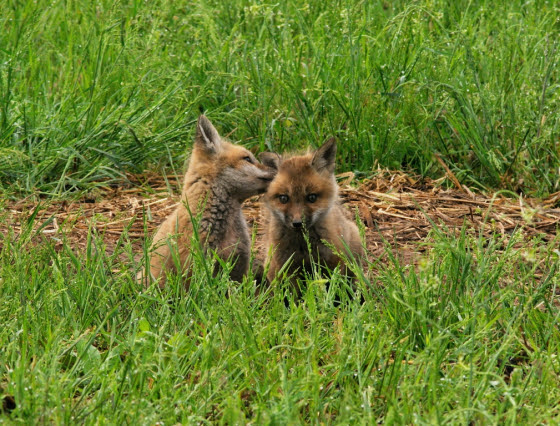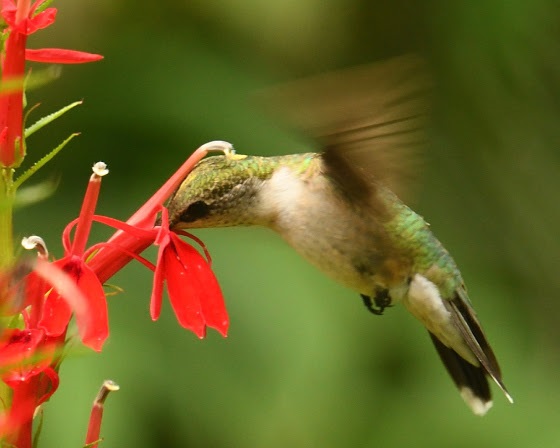Pollinators in Disguise
Article and photos by Joe Mish

The midsummer morning dew covered the green meadow grass with a transparent layer of condensation. In the light before sunrise the green grass appeared to be covered with a dull silver wash.
I was making a morning pilgrimage to an isolated jumble of trumpet vine in hope of capturing hummingbird images.
The freshly made trail of an animal, passing through the tall grass, caught my attention. Its fur wiped off the droplets of moisture clinging to the meadow grass. The image was that of a long single brush stroke of dark emerald green overlaying a dominant pewter green tinted background.
In the distance near the trumpet vine I saw a fox repeatedly bounce in the air as if on a trampoline. I edged closer hoping for a better view with binoculars.
The fox sat up and turned its attention to the tangle of vines covered with large trumpet shaped orange flowers.
As if out of curiosity the young fox stretched forward and sniffed among the vines and actually stuck its nose up one of the flowers. A closer look revealed a smudge of orange pollen on the tip of the fox’s wet black nose!
I knew what to look for or I would never have noticed the telltale pollen dust. Whenever I identified a flower for my daughter, she instinctively held the flower to her nose. The weaker the scent the closer to their nose it was placed. Curiosity then demanded another flower be sniffed in comparison to the first. Inevitably she would comment on the scent totally unaware the tip of her nose was smeared with bright colored pollen. In doing so, genetic material from one flower was transferred to another in an act of incidental pollination by a pollinator in disguise!
Flowers have evolved along with primary pollinators for mutual benefit. The flower’s structure provides an ergonomic accommodation resulting in an automatic pollen dispenser. This is essentially a primitive method of artificial insemination, where genetic material is collected from one individual and dispensed to another.
When we think of pollinators, honeybees and butterflies first come to mind. There are however, scores of other insect pollinators along with highly adapted birds, hummingbirds being a prime example. Bats and orioles are also listed as pollinators.
Primary pollinators and flowers have developed unique structures that fit together perfectly to serve the needs of both.
Bees have pollen baskets on the side of their legs while hummingbirds have the ability to hover motionless over a delicate stemmed flower and feed by way of a highly adapted beak and tongue, avoiding damage to their food source.
Flowers use color, shape and placement of reproduction structures to accommodate specific pollinators. Flat faced zinnias are perfect for bees and butterflies while the cone shaped flowers of trumpet vines are best suited for the long thin probing beaks of hummers. Specificity and dependence between species in nature often comes with a price. Where major crops like blueberries are grown, a die off of honey bees will result in a poor harvest. In this case, the relationship between pollinator and flower expands to include agriculture, economics, commerce and consumers.
The beauty of flowers extends to their adaptability to recruit incidental pollinators. When a non targeted pollinator, fox or human, walks though a field of flowers, pollen will collect on fur or clothing and brush off on other flowers. Not an efficient method of genetic transfer, but some pollination will occur.
If the inquisitive fox were to sniff another trumpet vine bloom, genetic transfer would be complete. That flowers can use a fox to transport pollen makes one wonder if an argument could be made that flowers are an intelligent life-form.
Consider that flowers are living things that in some magical way recruited man to further their propagation in exchange for a glimpse of eternal beauty, dreams and imagination to expand the universe of human potential with unbounded creativity and expression.
More detailed information on pollinators in NJ may be found at Conserve Wildlife New Jersey’s website. http://www.conservewildlifenj.org/protecting/projects/pollinators/

Author Joe Mish has been running wild in New Jersey since childhood when he found ways to escape his mother’s watchful eyes. He continues to trek the swamps, rivers and thickets seeking to share, with the residents and visitors, all of the state’s natural beauty hidden within full view. To read more of his writing and view more of his gorgeous photographs visit Winter Bear Rising, his wordpress blog. Joe’s series “Nature on the Raritan, Hidden in Plain View” runs monthly as part of the LRWP “Voices of the Watershed” series. Writing and photos used with permission from the author. Contact jjmish57@msn.com. See more articles and photos at winterbearrising.wordpress.com.
